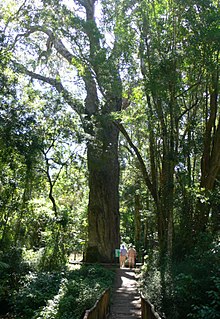Champion Trees of South Africa
In 2003, the Department of Agriculture, Forestry and Fisheries initiated the project to identify and grant special status to indigenous and non-indigenous trees in South Africa that meet certain set criteria.
From May to July 2003, workshops were held in Gauteng, KwaZulu-Natal and the Western Cape to gain consensus from experts to assist in the identification process of exceptional trees (Champion Trees) that are worthy of special protection throughout South Africa.
[1] The Department of Agriculture, Forestry and Fisheries initiated the Champion Trees Project with the purpose of identifying exceptional trees and regulating for their special protection using the National Forests Act of 1998 (NFA).
Under Section 15(1)(a) of the National Forests Act, such protected trees may not be "...cut, disturbed or damaged and their products may not be possessed, sold or transported without a licence...".
[1] Champion trees can be designated on a range of singular biological attributes: The Dendrological Society of South Africa, which maintains the National Register of Big Trees in South Africa, uses a formula of the combination of the three biological attributes to obtain the Size Index (SI):

